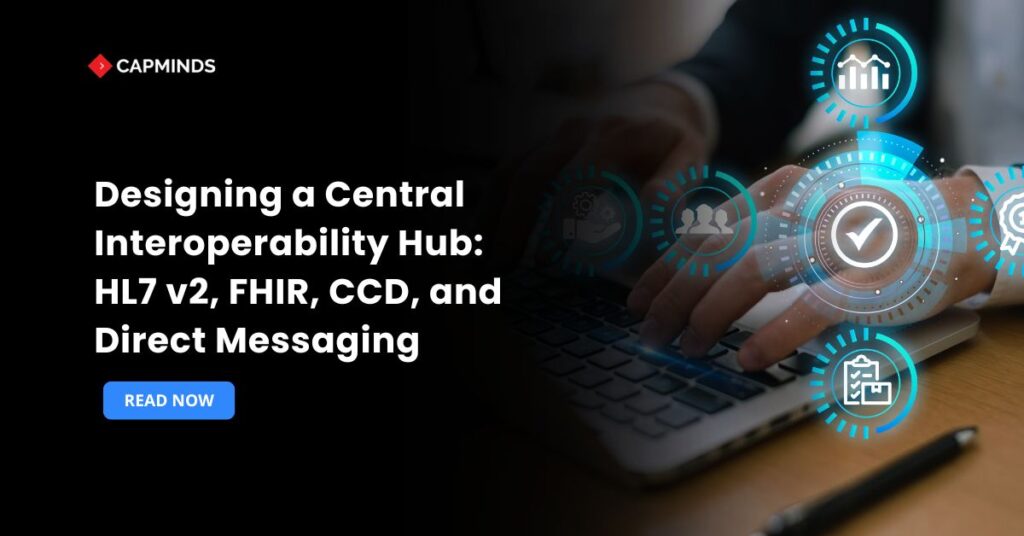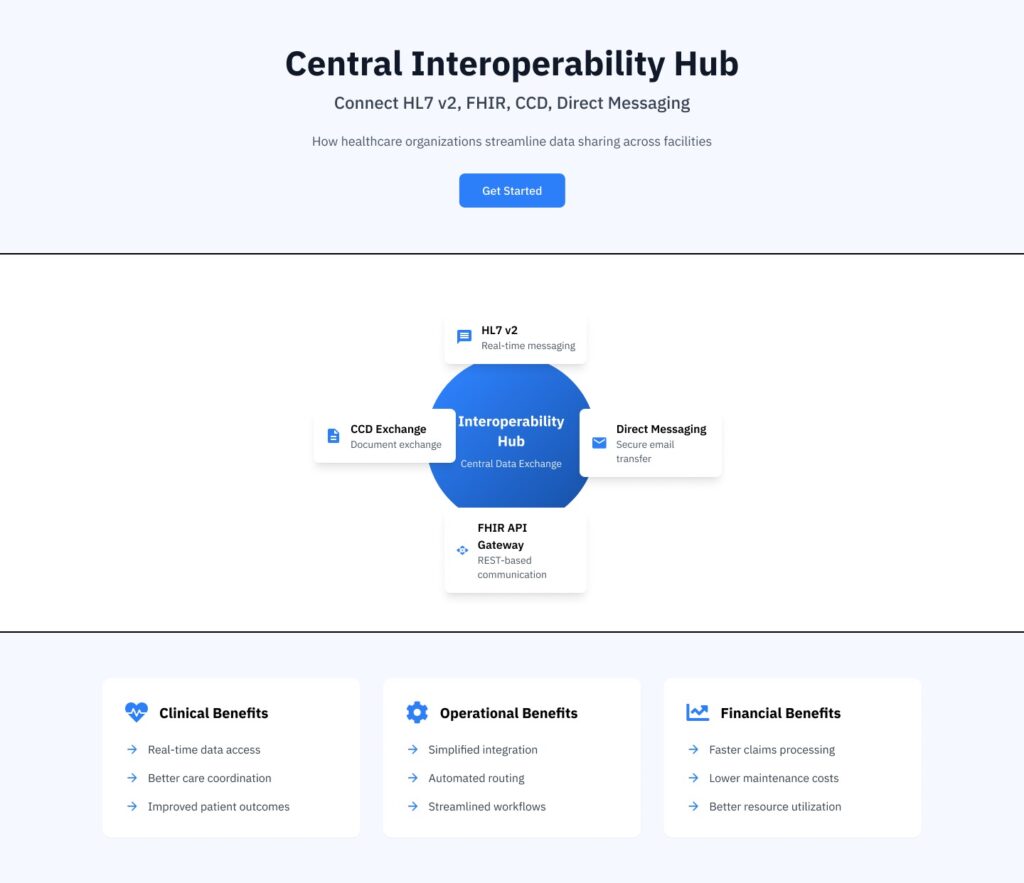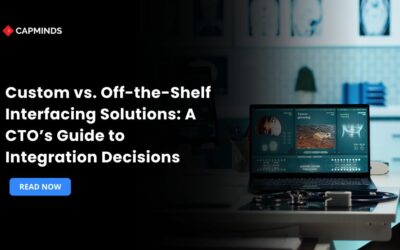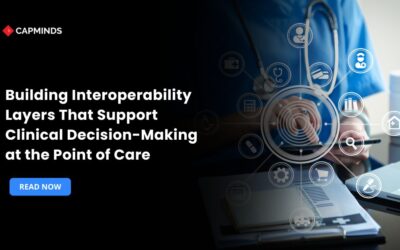Designing a Central Interoperability Hub: HL7 v2, FHIR, CCD, and Direct Messaging
Healthcare companies are under significant pressure to share clinical and administrative data across systems, locations, and care teams. Disparate data standards, regulatory requirements, and dispersed legacy systems, however, limit this. A Central Interoperability Hub can help with that by offering a scalable, standards-based method of coordinating communication across different health IT systems.
By integrating protocols like HL7 v2, FHIR, CCD, and Direct Messaging, organizations may improve healthcare decision-making, decrease data silos, and accelerate government-mandated compliance.
In this blog, you’ll know how to strategically construct such a hub for optimal interoperability and operational effectiveness.
The Core Standards: HL7 v2, FHIR, CCD, and Direct Messaging
Every interoperability standard has a distinct function in the exchange of medical data. Choosing the right combination ensures compatibility with both new and legacy systems.
- The most widely used protocol for real-time messaging in healthcare systems is still HL7 v2, especially in billing operations, ADT, and labs.
- HL7 created FHIR, a cutting-edge API-based standard intended for cloud integration, mobile apps, and patient-facing applications.
- Care transitions and structured clinical summaries require the use of CCD, an XML-based document format specified by the HL7 CDA standard.
- Secure clinical communication using email-like protocols is made possible via Direct Messaging, which is supported by the ONC and used in Meaningful Use projects.
Architecture of a Central Interoperability Hub
The hub’s architecture should be modular, adaptable, and expandable to meet changing healthcare demands and standards. The ideal design consists of a message broker, an interface engine, and a data normalization layer.
The key architectural components are:
- The Interface engine, like Mirth Connect, converts, routes, and transforms communications between HL7 v2, CCD, and FHIR formats.
- FHIR Gateway serves as a RESTful API gateway for both external apps and internal analytics tools.
- CCD Parser/Generator converts organized clinical summaries into usable, interoperable documents.
- The Direct Secure Messaging Node transmits and receives encrypted messages that include trust bundles, provider directories, and certificates.
Verify that every module integrates easily with your imaging systems, lab information system, billing system, and EHR.
Related: Top Middleware Tools for HL7, CCD, and Claims Integration
Benefits of a Unified Interoperability Hub
Clinical Benefits
- Real-time access to patient information across facilities
- Reducing redundant testing and medical mistakes
- Smooth care transfers between general care and specialists
Operational Benefits
- Simplified interface management with a single point of exchange
- Rapid integration with new partners and systems
- Automated routing of referrals, ADTs, and care summaries
Financial Benefits
- Improved claims processing accuracy
- Reduced integration and maintenance expenses
- Improved compliance with CMS and ONC interoperability regulations
Integration Workflow: How the Hub Connects the Dots
Integration should follow a hub-and-spoke approach, with the central engine serving as a bridge between source and destination systems. Here’s how a typical data exchange happens:
- Inbound messages like HL7 v2 or CCD are captured by the interface engine, validated, and translated into a common internal data model.
- Routing logic identifies target systems based on message type and information. Activates transition into FHIR or CCD as needed.
- Outbound Delivery Sent using REST API FHIR, Direct Messaging (CCD), or HL7 socket.
- Logging and auditing monitor message status, timestamps, and exceptions for compliance.
Establishing this procedure promotes data quality and ensures that communications follow regulatory and commercial norms.
Common Use Cases in Hospital Settings
Hospitals can use a central interoperability hub in a variety of real-world scenarios:
- Emergency Room Coordination – Real-time ADT updates are exchanged with the regional health information exchange.
- Referral Management – Automatically forwarding CCDs and visit notes to external specialists using Direct Messaging.
- Laboratory and Imaging Integration – Bidirectional HL7 v2 connects with LIS and PACS to receive orders and deliver findings.
- Patient Access Apps – FHIR APIs provide real-time prescription, encounter, and vaccination data to patient portals.
These application cases improve care continuity, minimize manual effort, and assist providers with interoperability compliance.
Challenges and Best Practices
While the benefits are great, deploying a central hub presents challenges:
- HIPAA-compliant access and patient consent restrictions are upheld by security and consent management.
- Interface changes, version upgrades, and partner-specific requirements are all part of ongoing maintenance.
- Ongoing maintenance includes interface updates, version upgrades, and partner-specific requirements.
The Best Techniques for addressing these difficulties include
- Create reusable interface templates for HL7 and FHIR.
- Using sophisticated validation techniques to detect mistakes before transmission.
- Implementing role-based access and data recording to ensure audit readiness
- Working with experienced integration suppliers
Unlock Seamless Interoperability With CapMinds
At CapMinds, we help hospitals and healthcare organizations build secure, scalable, and standards-based interoperability hubs that eliminate data silos and drive better outcomes.
Whether you’re working with HL7 v2, FHIR, CCD, or Direct Messaging, we’ve got you covered.
With CapMinds, you can:
- Build customized interfaces with HL7 v2, FHIR, CCD, and Direct Messaging
- Seamlessly connect EHRs, LIS, RIS, PACS, billing systems, and third-party apps
- Enable real-time patient data sharing and streamline care coordination
- Ensure regulatory compliance with ONC, TEFCA, and CMS rules
- Reduce integration costs and accelerate the onboarding of new systems
Ready to streamline your healthcare data exchange?
Let CapMinds architect your Central Interoperability Hub, built for compliance, speed, and scale. Contact CapMinds today for a free consultation.





